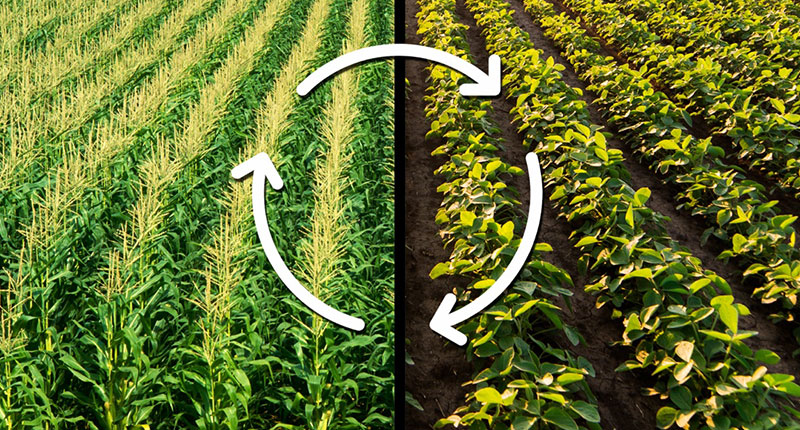
Crop rotation has been used in agriculture for centuries, but in recent years it has become increasingly popular due to its numerous benefits for sustainable farming. Crop rotation involves alternating the crops grown in a field over several growing seasons, and it can help to reduce pest and disease pressure, improve soil health, and increase crop yields. In this article, we will explore the benefits of crop rotation in more detail.
What is Crop Rotation?
Crop rotation is the practice of growing different crops in the same field in a specific sequence over several growing seasons. The idea behind crop rotation is to alternate crops with different nutrient requirements and growth habits to improve soil health and reduce pest and disease pressure. The crops grown in a rotation will depend on the region, climate, and soil type, but common crops include corn, wheat, soybeans, and legumes.
Benefits of Crop Rotation
1. Improved Soil Health
One of the main benefits of crop rotation is improved soil health. Different crops have different nutrient requirements, and by rotating crops, farmers can help to ensure that the soil is not depleted of essential nutrients. Additionally, different crops have different root structures, and by alternating crops, farmers can help to improve soil structure and reduce soil erosion.
2. Reduced Pest and Disease Pressure
Crop rotation can also help to reduce pest and disease pressure. When the same crop is grown in the same field year after year, pests and diseases can build up in the soil, making it more difficult to grow that crop in the future. By alternating crops, farmers can disrupt the pest and disease life cycle, reducing the overall population and making it easier to control.
3. Increased Crop Yields
Another benefit of crop rotation is increased crop yields. By alternating crops with different nutrient requirements and growth habits, farmers can help to ensure that the soil is not depleted of essential nutrients and that crops are not competing for resources. This can result in higher yields and better crop quality.
4. Weed Control
Crop rotation can also help to control weeds. Different crops have different weed pressures, and by rotating crops, farmers can help to reduce the overall weed population. Additionally, certain crops, such as legumes, can help to fix nitrogen in the soil, reducing the need for synthetic fertilizers and making it more difficult for weeds to grow.
How to Implement Crop Rotation
Implementing crop rotation involves careful planning and management. Farmers must choose which crops to grow in each field and in what order, taking into account the nutrient requirements, growth habits, and pest and disease pressures of each crop. Additionally, farmers must manage the soil carefully, ensuring that it is properly fertilized, irrigated, and tilled.
Conclusion
In conclusion, crop rotation is a valuable practice for sustainable agriculture. It can help to improve soil health, reduce pest and disease pressure, increase crop yields, and control weeds. By carefully planning and managing crop rotations, farmers can ensure that their fields remain productive and healthy for years to come.
FAQs
1. What is the best crop rotation sequence?
- The best crop rotation sequence will depend on the region, climate , and soil type. Farmers should consult with agricultural experts to determine the best rotation for their specific needs.
2. How often should crops be rotated?
- Crops should be rotated every 2-5 years, depending on the crop and the specific needs of the soil.
3. Can crop rotation help to reduce the use of synthetic fertilizers?
- Yes, by alternating crops, farmers can reduce the need for synthetic fertilizers and promote natural nutrient cycling in the soil.
4. What are the disadvantages of crop rotation?
- The disadvantages of crop rotation include the need for careful planning and management, as well as potential reductions in short-term yields.
5. Is crop rotation suitable for all types of crops?
- Crop rotation can be used for many different types of crops, but the specific rotation will depend on the crop and the needs of the soil.
6. How can crop rotation benefit the environment?
- Crop rotation can benefit the environment by reducing the need for synthetic fertilizers and pesticides, promoting natural nutrient cycling, and improving soil health and water quality.
7. What are some common crops used in crop rotation?
- Common crops used in crop rotation include corn, wheat, soybeans, legumes, and cover crops.
8. Can crop rotation help to reduce soil erosion?
- Yes, by alternating crops with different root structures and growth habits, crop rotation can help to improve soil structure and reduce soil erosion.
9. How can farmers learn more about crop rotation?
- Farmers can learn more about crop rotation by consulting with agricultural experts, attending workshops and conferences, and conducting their own research.
